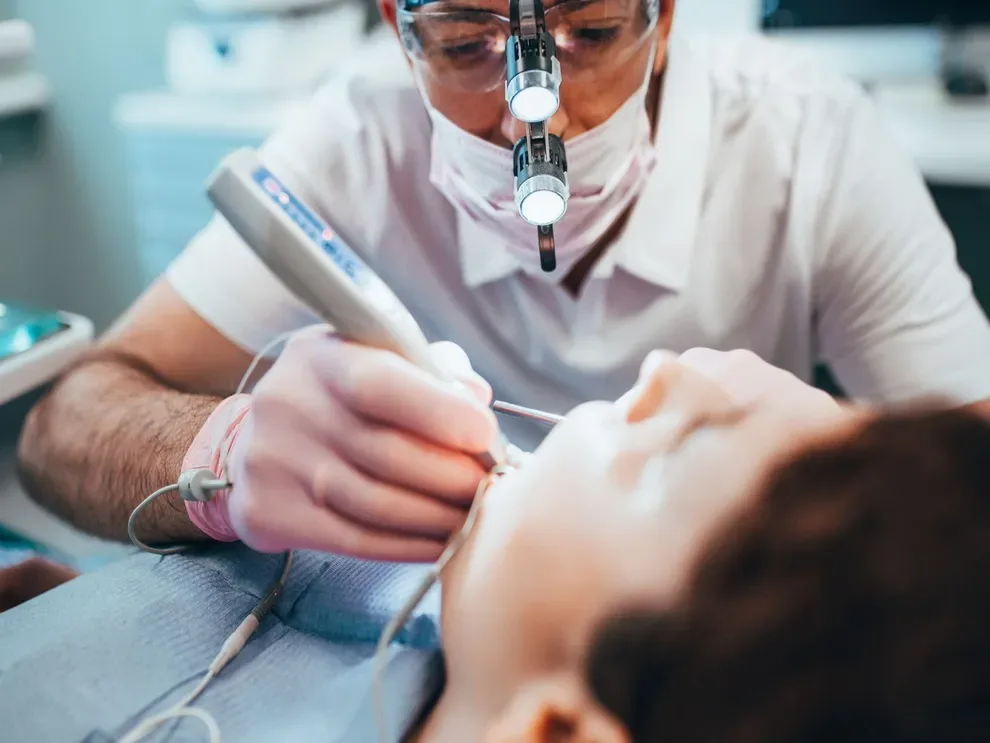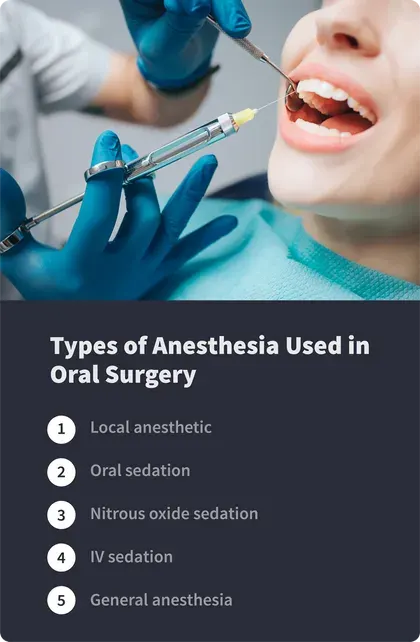Main Types of Anesthesia for Oral Surgery

Table of Contents
- What Is Anesthesia
- Who Should Undergo Anesthesia?
- Common Types of Anesthesia in Oral Surgery
- Is Anesthesia Safe?
- Alternatives to Anesthesia
- References
Anesthesia is the process of dulling pain in a medical setting using combinations of analgesics and sedatives. Physicians use five main types of anesthesia for oral surgery:
Local anesthetic
Oral sedation
Nitrous oxide sedation
IV sedation
General anesthesia
Each type offers specific advantages and drawbacks that make it more suitable to specific procedures. Your dentist will advise you about the options available to you before your oral surgery and help you select the one that meets your needs.
Several alternatives to anesthesia are also available to patients who opt not to use any of these five methods. These other techniques can help control the pain of oral surgery with fewer injections, chemicals, and other intimidating aspects of traditional anesthesia.
What Is Anesthesia?

Anesthesia is the medical term for controlled loss of sensation. There are two components to it: analgesics and sedatives.
Analgesics are pain medications. They may be delivered orally (in pill form), through inhalation, by injection, or as a topical cream or ointment.
Sedative medications aim to calm patients and dull their senses. A patient who is sedated may be just slightly drowsy or completely unconscious. The reaction depends on the strength of the treatment.
Who Should Undergo Anesthesia?
Some forms of anesthesia is used in many dental procedures. If you are undergoing any sort of dental procedure, you may be a candidate for anesthesia, especially if you are very sensitive to tooth pain or have anxiety about your dental treatment.
A local topical anesthetic is often used in common procedures like cavity fillings, gum treatments, and in preparing teeth for tooth crowns.
Sedation, including minimal sedation (often using nitrous oxide, known as laughing gas) and IV sedation, is sometimes used in more major procedures, like certain wisdom teeth or dental implant treatments. Sedation may also be used to treat patients who have severe anxiety about their dental treatment.
General anesthesia (sometimes referred to as going under or being put to sleep) puts someone in an unaware and unconscious state. It is the most extreme form of anesthesia and may be used for procedures like implant placement, wisdom tooth removal, or jaw surgery.
Some form of sedation or even general anesthesia may be used for procedures on children to ensure they are able to sit still and receive proper and safe care.
Your dentist will decide if anesthesia is needed and discuss the options with you.
Common Types of Anesthesia Used in Oral Surgery
Local anesthetic is injected into the patient's gums before oral surgery to numb the area where the dentist will be working. Several different drugs may be used for this purpose, including these:
Lidocaine
Articaine
Bupivacaine
Almost every dental procedure uses local anesthetic as a first-line method of pain control. As long as the procedure is short (under two hours) and the patient is relatively calm, this type of anesthesia is usually sufficient for oral surgery.
If a patient is anxious about getting dental work done, their dentist may also give them an oral sedative (usually benzodiazepines such as Valium or Ativan) along with their local anesthetic.Oral sedation produces mild to moderate levels of sedation depending on the dosage. It is effective for most patients, especially adults with mild or severe dental or surgical anxiety.
Nitrous oxide sedation (laughing gas) involves breathing in a controlled combination of nitrous oxide and oxygen using a gas mask. You are usually still conscious while under nitrous oxide sedation, but you won't feel anything or remember very much of the procedure.
Nitrous oxide sedation is stronger than oral sedation, and it is safer and more accessible than IV sedation. It is often used for anxiety-ridden patients who are undergoing basic oral surgeries like wisdom tooth extraction or a root canal.
IV sedation involves feeding a steady stream of sedative medication into a patient's bloodstream using an IV line. These are the most common medications used:
Benzodiazepines
Opioids (in safe doses)
Propofol
IV sedation provides a deeper level of sedation than either oral or nitrous oxide sedation. It also takes effect much faster than other types of sedation and leaves you with virtually no memory of what took place.
However, administering this type of anesthesia is also significantly more complicated. If done improperly, it can cause your heart rate or breathing to drop to dangerously low levels. For this reason, IV sedation requires additional training, and not all dentists are certified to offer it.
Dentists who do not offer this service will often suggest that their patients choose nitrous oxide sedation instead.
General anesthesia is the strongest form of anesthesia used in dental surgery. Patients who are given general anesthesia are completely unconscious throughout the entire procedure. They won't feel or remember anything that was done during the surgery.
This form of anesthesia appeals to many people who have a high degree of anxiety about undergoing oral surgery.
However, the decision to go under general anesthetic should not be taken lightly. This is the riskiest form of anesthesia, especially for young children, elderly people, and those with common conditions such as diabetes and high blood pressure. Although it is considered safe, you should only undergo oral surgery under general anesthesia if your oral surgeon believes it is absolutely necessary.
It is requested to have no food or drinks eight hours before your procedure if you have IV sedation or general anesthesia.
Is Anesthesia for Oral Surgery Safe?
While there are risks involved with every form of anesthesia, dentists and dental surgeons are extensively trained in anesthesia. Using this training, along with their knowledge of your health background, they will be able to determine if anesthesia is needed and which type is safest for you.
Your dentist or surgeon may need to bring in an outside anesthesiologist to administer certain types of anesthesia.
To make sure your dentist or surgeon is able to provide you with the safest anesthesia treatment possible, it’s very important that you are honest and comprehensive when explaining any health problems or procedures you’ve had. It’s also imperative that you follow any instructions given to you about eating, drinking, and taking medications before and after the surgery.
Alternatives to Anesthesia
Some patients are poor candidates for anesthesia, afraid of needles, or uncomfortable with the idea of injecting chemicals into their body.
If you would prefer that your dentist or surgeon doesn’t use typical dental anesthesia, one of several alternatives might better suit your needs.
These ointments provide extremely safe and needle-free pain relief, but they lack the strength of other methods.
Some dentists are now performing oral surgery using laser drills instead of mechanical hand drills. These drills cause very little pain, often making anesthesia unnecessary.
This type of anesthesia controls pain by manipulating the nervous system with small electrical shocks from a TENS machine.
These techniques promote a calm frame of mind and cause the body to release natural analgesic chemicals.
Some patients have used hypnosis to calm themselves before their dental surgery, allowing them to opt for less intensive anesthesia.
Anyone who undergoes a dental procedure that involves the possibility of pain and anxiety has several options to choose from when it comes to the surgery. Don’t be afraid to ask your dentist or oral surgeon about your choices.
